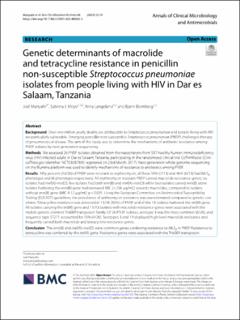Genetic determinants of macrolide and tetracycline resistance in penicillin non-susceptible Streptococcus pneumoniae isolates from people living with HIV in Dar es Salaam, Tanzania
Journal article, Peer reviewed
Published version

View/
Date
2023-02-20Metadata
Show full item recordCollections
- Department of Clinical Science [2295]
- Registrations from Cristin [9489]
Original version
Annals of Clinical Microbiology and Antimicrobials. 2023, 22, 16. 10.1186/s12941-023-00565-3Abstract
Background: Over one million yearly deaths are attributable to Streptococcus pneumoniae and people living with HIV are particularly vulnerable. Emerging penicillin non-susceptible Streptococcus pneumoniae (PNSP) challenges therapy of pneumococcal disease. The aim of this study was to determine the mechanisms of antibiotic resistance among PNSP isolates by next generation sequencing.
Methods: We assessed 26 PNSP isolates obtained from the nasopharynx from 537 healthy human immunodeficiency virus (HIV) infected adults in Dar es Salaam, Tanzania, participating in the randomized clinical trial CoTrimResist (ClinicalTrials.gov identifier: NCT03087890, registered on 23rd March, 2017). Next generation whole genome sequencing on the Illumina platform was used to identify mechanisms of resistance to antibiotics among PNSP.
Results: Fifty percent (13/26) of PNSP were resistant to erythromycin, of these 54% (7/13) and 46% (6/13) had MLSB phenotype and M phenotype respectively. All erythromycin resistant PNSP carried macrolide resistance genes; six isolates had mef(A)-msr(D), five isolates had both erm(B) and mef(A)-msr(D) while two isolates carried erm(B) alone. Isolates harboring the erm(B) gene had increased MIC (> 256 µg/mL) towards macrolides, compared to isolates without erm(B) gene (MIC 4-12 µg/mL) p < 0.001. Using the European Committee on Antimicrobial Susceptibility Testing (EUCAST) guidelines, the prevalence of azithromycin resistance was overestimated compared to genetic correlates. Tetracycline resistance was detected in 13/26 (50%) of PNSP and all the 13 isolates harbored the tet(M) gene. All isolates carrying the tet(M) gene and 11/13 isolates with macrolide resistance genes were associated with the mobile genetic element Tn6009 transposon family. Of 26 PNSP isolates, serotype 3 was the most common (6/26), and sequence type ST271 accounted for 15% (4/26). Serotypes 3 and 19 displayed high-level macrolide resistance and frequently carried both macrolide and tetracycline resistance genes.
Conclusion: The erm(B) and mef(A)-msr(D) were common genes conferring resistance to MLSB in PNSP. Resistance to tetracycline was conferred by the tet(M) gene. Resistance genes were associated with the Tn6009 transposon.
